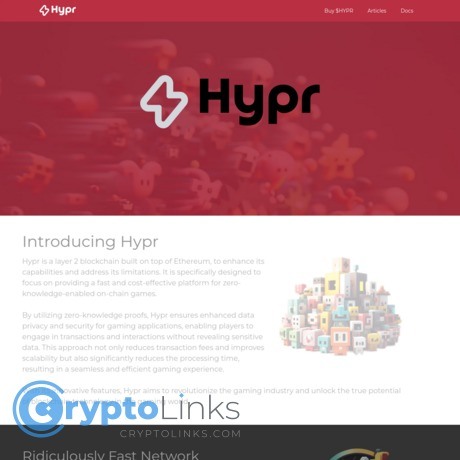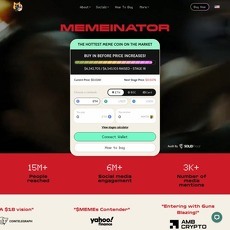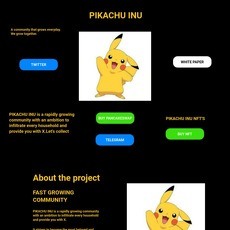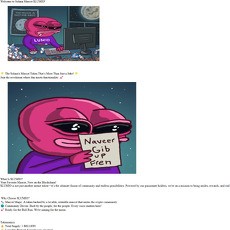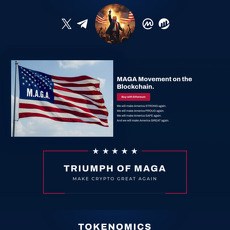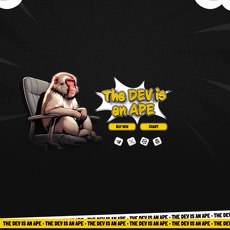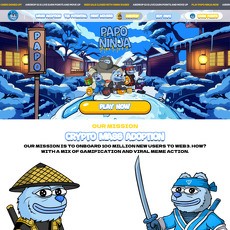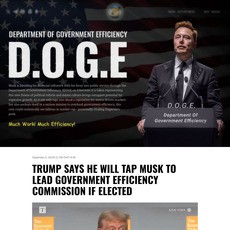Hypr Review
Hypr
hypr.network
If your website is on the scam list and you think that you are not a scammer, contact us. After you provide us with all the proof that you are in Crypto World with good intentions, we will delist you. Usually, you get in this category because you are hiding your team, you have a bad reputation(you are tricking, deceiving, scamming people), and you haven't got a written project whitepaper or is a shitty one....
Their Official site text:
What is Hypr Network?
Introduction
is an OP layer 2 blockchain built on top of Ethereum, to enhance its capabilities and address its limitations. It is built with OP Stack and specifically designed to focus on providing a fast and cost-effective platform for zero-knowledge-enabled on-chain games.
By utilizing zero-knowledge proofs, Hypr ensures enhanced data privacy and security for gaming applications, enabling players to engage in transactions and interactions without revealing sensitive data. This approach not only reduces transaction fees and improves scalability but also significantly reduces the processing time, resulting in a seamless and efficient gaming experience.
With its innovative features, Hypr aims to revolutionize the gaming industry and unlock the true potential of blockchain technology in the gaming world.
Hypr Website
Zero-Knowledge Proofs
Exploring Zero-Knowledge Proofs: History, Meaning, and Their Pivotal Role in Blockchain
In the world of blockchain technology, privacy and security have become paramount concerns. One groundbreaking solution that has gained significant attention in recent years is the concept of zero-knowledge proofs (ZKPs). In this comprehensive blog post, we'll dive deep into the history, meaning, and applications of zero-knowledge proofs, with a specific focus on their pivotal role in blockchain.
Understanding Zero-Knowledge Proofs
What are Zero-Knowledge Proofs?
Zero-knowledge proofs are cryptographic protocols that allow one party, the prover, to demonstrate to another party, the verifier, that they possess specific information without revealing the actual information itself. In simpler terms, it enables you to prove knowledge of a secret without disclosing the secret itself.
The Three Properties of Zero-Knowledge Proofs
Completeness: If the statement is true, an honest verifier will be convinced of its truth by an honest prover.
Soundness: If the statement is false, no cheating prover can convince an honest verifier that it is true.
Zero-Knowledge: If the statement is true, the verifier learns nothing about the secret except that the statement is true.
A Brief History of Zero-Knowledge Proofs
Origin and Early Developments
Zero-knowledge proofs were first introduced in a groundbreaking paper titled "The Knowledge Complexity of Interactive Proof Systems" by Shafi Goldwasser, Silvio Micali, and Charles Rackoff in 1985. This paper laid the theoretical foundation for the concept of zero-knowledge proofs.
Practical Applications
Over the years, zero-knowledge proofs have evolved from a theoretical concept to practical cryptographic tools. They have found applications in various fields, including secure authentication, password-based systems, and digital currencies.
Zero-Knowledge Proofs in Blockchain
The Need for Privacy in Blockchain
Blockchain technology offers transparency and immutability, but it lacks privacy. Traditional blockchain transactions are pseudonymous, meaning that the sender and receiver addresses are visible, and anyone can trace the transaction history. This lack of privacy has led to concerns about user anonymity.
How Zero-Knowledge Proofs Enhance Privacy in Blockchain
Zero-knowledge proofs play a transformative role in enhancing privacy within blockchain ecosystems. They enable:
Confidential Transactions: Zero-knowledge proofs can be used to hide transaction amounts while still proving their validity.
Private Smart Contracts: ZKPs can be employed to verify the correctness of computations in smart contracts without revealing the input data.
Identity and Authentication: Users can prove they have certain credentials (e.g., age verification) without revealing their actual age or personal information.
Real-World Examples
Zcash: Zcash, a privacy-focused cryptocurrency, uses zero-knowledge proofs (zk-SNARKs) to enable private transactions.
Ethereum and Rollups: Ethereum, the second-largest blockchain by market cap, is exploring the integration of zk-Rollups to improve scalability and privacy.
ID Verification: Several blockchain projects are exploring zero-knowledge proofs for identity verification, allowing users to prove their identity without disclosing sensitive information.
Challenges and Future Directions
Scalability and Efficiency
While zero-knowledge proofs offer powerful privacy solutions, they can be computationally intensive. Researchers and developers are actively working on improving the efficiency and scalability of ZKP implementations.
Wider Adoption
Wider adoption of zero-knowledge proofs in blockchain and other industries depends on education, user-friendly interfaces, and continued research and development.
Conclusion
Zero-knowledge proofs have emerged as a crucial tool in the world of blockchain technology, providing a solution to the privacy and security challenges that have plagued the industry. Their ability to enable private transactions, secure smart contracts, and verify identities while preserving user privacy makes them a cornerstone of the blockchain revolution. As blockchain technology continues to evolve, zero-knowledge proofs are likely to play an even more significant role in shaping its future.
Tokenomics
This page contains every single FAQ you could ever think of about the tokenomics of the Hypr Network.
What is the address of HYPR token?
What are the tokenomics of HYPR?
The HYPR token has a fixed supply of 100,000,000 tokens, allocated in the following ways:
70,000,000 (70%) was allocated to the uniswap v2 pool in a fair launch manner, which means that the team had access to buy the tokens at the same time and price as the general public. The team had no information or time advantage.
30,000,000 (30%) was set aside to be used for retroactive rewards for developers and users and partners that deploy their app on Hypr Network. . The details of the retroactive airdrop is still TBD.
Our goal is to create a network that is owned by its community members, but balanced in a way to also reward developers and users of applications that deploy on Hypr Network.
Our goal is sustainable growth as a network and the 30% in a multisig wallet will allow Hypr to grow responsibly.
What is the purchase limit per wallet address? Why have that?
The purchase amount limit per wallet address is 100,000 $HYPR Tokens. The reason for this limit are as follows:
As a fair launch project, the initial market capitalization is very low. Putting purchase limits prevents any single actor to acquire a meaningfully large amount of the liquidity pool.
By setting limits, we are purposely putting the community first by creating an environment of healthy buying, selling, trading, swapping, and holding. We want holders of $HYPR to be both small and large and anything in between. At bottom, we want things fair and also broadly inclusive. We want everyone involved and participate in the Hypr Network.
What is the address of the Uniswap v2 Pool?
Is Uniswap Liquidity locked? Tell me more.
The Hypr team plans on locking the uniswap v2 LP tokens. In terms of timing, we do not have an ETA on that but, rest assured, we plan on locking liquidity within 7 days of creating the uniswap v2 pool.
We are working with Floki team, the creator of Flokifi, the well-known and respected locker for liquidity.
We will share more information as this becomes more relevant.
How does Staking Rewards work?
User must hold a minimum of 100,000 HYPR tokens.
Once per week, we will do an unannounced snapshot. At the end of the calendar month, we will take the average of snapshots and the average of all snapshots taken must be at least 100,000 or greater to qualify for the staking rewards.
No staking or lockup. Just hold the tokens in a non-custodial wallet (i.e., NOT a centralized exchange (CEX) wallet address like Binance).
Staking reward is distributed in $HYPR by default.
Claiming rewards requires a minimum of 0.1 ETH accumulated.
Users have 14 days to claim. After the claim period, the rewards will be used to purchase $HYPR tokens in the open market and burned. The team will do its best to remind users to claim and announce publicly during the 14 day claim period.
Later, per our product roadmap, we plan on adding a Lock feature where the user is able to lock their HYPR tokens for a boost on their rewards.
Claim rewards launching soon.
How much staking reward will I get?
How much you will get depends on the following:
How much sell volume there was of the $HYPR token during the calendar month.
How much $HYPR Tokens you held for the given calendar month.
More specifically,
You will receive a proportional share of rewards based on the number of HYPR tokens held.
For example let’s assume there are 5 users that qualify for staking reward in October and the number of HYPR tokens each owns:
BAM BAM: 200,000 HYPR Tokens
Bart, 500,000 HYPR Tokens
Victoria, 400,000 HYPR Tokens
Mina, 700,000 HYPR Tokens
Augustus, 1,000,000 HYPR Tokens
There are a total of 5 ETH in the rewards wallet, collected from Sell orders of HYPR tokens in the month of October. This means, each qualifying user gets:
What is my staking reward composed of?
As of this writing (Oct 30, 2023), staking reward is comprised primarily of sale taxes. This means for every sell of $HYPR tokens, the transaction is taxed 5%, broken out in the following ways:
1% goes back to the Uniswap v2 liquidity pool.
2% goes toward staking rewards.
2% goes toward operating expenses such as marketing and business development.
What are the benefits of holding HYPR?
You can qualify for the monthly staking rewards.
Eventually, holding $HYPR Tokens will allow you to participate in governance decisions and vote on proposals. Hypr Network is community-owned, which means you get a voice in which the direction the protocol should go.
How do I claim my rewards?
Easy. Simply go to claim dashboard (launching soon). Connect your wallet. Hit claim, pay gas, you're done.
How do I qualify for rewards?
We've .
When can I claim my rewards?
Snapshots will be taken during the month. If your wallet qualifies and has at least 100,000 $HYPR Tokens and the revshare wallet has sufficient rewards to distribute to holders, then the rewared claim will be available in the first 7 days of the following month.
For example, it is November. During November, snapshots will be taken. At the end of the month, the average of the snapshots for any given wallet will be taken to determine eligibility. If eligible, then claim will be open in the first 7 days of December to claim for the month of November.Hypr Cards SDK
Hyper Cards SDK is an all-purpose tool set that enables game developers to easily build any on-chain card games employing zero-knowledge proof technology.
The problem we solved
Creating card game protocols on public blockchains poses several challenges. One of the main challenges is the need for players to hide their card values from each other, whereas on-chain information is absolutely transparent due to the nature of blockchain technology. On-chain data encryption or obfuscation can be achieved using cryptographic techniques such as zero-knowledge proofs or secure multi-party computation, but these techniques can be very complicated and require a steep learning curve for game developers. And that is why we’re here to do all the heavy lifting on cryptography in Hyper blockchain and ship a set of well-designed zero-knowledge card game SDK (with complex contained) and tools so game developers can only focus on their games.
The Solidity APIs for smart contract
After taking a good hard look at how card games work in the real world, we found a bunch of common things that they all need to do. Then the magic zero-knowledge proof tech was used to build a sweet set of APIs for card games that can handle all these common operations. We made it super easy for game developers to use our APIs by packaging them up as precompiled smart contracts that can be plugged right into their Ethereum Virtual Machine (EVM) game contracts. This way, they can focus on making their games awesome without having to worry about reinventing the wheel every time.
Dive in and look at a sample or continue reading below.
API name
Description
computeAggregateKey()
Compute aggregation public key
mask()
Mask a playing card
reveal()
Reveal a masked playing card
Solidity Interface
Contract Address
Mental Poker Exec
0x0000000000000000000000000000000000000040
API name
Description
verifyKeyOwnership()
Verify proof of ownership of a game key
verifyShuffle()
Verify proof of shuffling of deck
verifyReveal()
Verify proof of reveal token of a card
Solidity Interface
Contract Address
Mental Poker Verify
0x0000000000000000000000000000000000000030
The Typescript/Javascript API for game client
API name
Description
keygen()
Create a random game key pair
setup()
Create a public parameter to setup game instance
encodeCards()
Generate an initial encoded deck of playing cards
mask()
Mask an encoded card
shuffleAndRemask()
Shuffle and remask the deck of cards, off-chain, with a random permutation
computeRevealToken()
Compute a reveal token for a given masked card
reveal()
Reveal a masked card to see its original value
What can be built with the zkGaming SDK?

